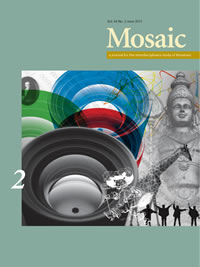Issue 44.2
Overview

General Issue
Published: June 2011
View the issue introduction or see the issue summary and contents below.
11 essays, totalling 192 pages
$19.95 CAD
This general issue models the interdisciplinarity that Mosaic is all about. It includes eleven essays that engage a diverse range of topics, among them: ecocritical theory’s theory, animal ethics, the status of “the subject,” the gaze, trauma and the “wounded” body, the public/private dichotomy and the division between high and low culture, diasporic translocation and “the multicultural question” in Malaysia, migration, incorporating European folklore into Okanagan traditions of story, indolence and creativity in the Beatles and in British Romanticism.
Re-covering the Scarred Body: Textual and Photographic Narratives of Breast CancerStella Bolaki Reading first-person breast cancer narratives—textual and photographic—from the late seventies to the present, this essay examines how photographs can insert themselves into a heterogeneous tradition of illness narratives, inflecting current debates in breast cancer representation and even changing the framework of thinking about the disease. | |
Diasporic Translocation and “The Multicultural Question” in MalaysiaSharmani Patricia Gabriel Contrary to perspectives stressing diaspora as a discourse of exile and loss, this essay foregrounds the “national” tendencies and affiliations of diasporic communities. Focusing on the Southeast Asian nation-state of Malaysia, it examines the literary productions of K.S. Maniam to show how they disrupt hegemonic notions about diaspora and emphasize the transformative capacity and national consciousness of diasporic communities. | |
The Rhetoric of Harry Robinson’s “Cat With Boots On”Mareike Neuhaus Tracing a series of symbols as the main rhetorical design in Harry Robinson’s “Puss in Boots,” this essay presents Robinson’s text as a rhetorically ingenious incorporation of a European folktale into Okanagan traditions of story and thought deeply informed by Indigenous notions of peoplehood. | |
The Literary Text as Talking Cure: A Psychoanalytic Interpretation of Restlessness.Hilde Staels This essay relies on the psychoanalytic literary theories of Peter Brooks and Julia Kristeva to examine the transferential relationship between the analysand-narrator and the analyst-narratee in the novel Restlessness. Van Herk uses typical conventions of the psychoanalytic talking cure to unsettle the common reader’s desire for linearity and final meaning. | |
“Look at me”: The Camera Obscura and the Apprenticeship of the Gaze in Tracy Chevalier’s Girl with a Pearl EarringPauline Morel This essay focuses on the apprenticeship of the gaze in Tracy Chevalier’s Girl with a Pearl Earring, particularly the voyeuristic, transformative, sexual, fetishist, and capitalistic implications of the gaze. Griet’s development of her aesthetic sense is self-defining, and accompanied by a familiarization with a visual culture epitomized by the camera obscura, the symbolism of which resonates throughout the novel. | |
Vers une écocritique française: Le contrat naturel de Michel SerresStéphanie Posthumus Alors que l’écocritique est bien connue comme étude du rapport entre l’écologie et la littérature dans le domaine des lettres anglaises et américaines, elle reste curieusement absente du monde des lettres françaises. Notre analyse se propose de combler cette lacune en fondant une écocritique française sur le concept du contrat naturel de Michel Serres. | |
Detecting Outside History in The No. 1 Ladies’ Detective AgencyClare Counihan Buttressed by various paratexts, the novel and film The No. 1 Ladies’ Detective Agency deploy ethnographic strategies to authorize themselves as realistic representations of Botswana. This essay argues that this use of ethnographic realism and salvage ethnography, respectively, reveal Western desires that Africa remain ahistorical and “authentic.” | |
Giving Up Control: Narrative Authority and Animal Experience in Coetzee and KafkaMichael O’Sullivan Animal experience is central to the fiction of J.M. Coetzee and Franz Kafka. In light of new approaches to animal awareness in science and philosophy, this essay investigates how Coetzee’s deliberations on the animal, initially by way of Kafka, extend the range of narrative authority and reappraise human empathy. | |
Not “Only Sleeping”: The Beatles and a Neo-Romantic Aesthetic of IndolenceJohn McCombe This essay explores both the tension between indolence and creativity in selected Beatles lyrics and a corresponding connection to British Romanticism. In addition to discussing more general affinities between mid-period Beatles songs and Romantic poetry, the essay suggests how poetry and popular music reflect two centuries of shifting attitudes toward indolence. | |
Ecocriticism’s Theoretical DiscontentsSerpil Oppermann This essay both reflects upon ecocriticism’s investment in cultivating environmental consciousness at a distance from critical reflexivity and explores its theoretical discontents. Arguing for the necessity of bringing theory into praxis, the essay suggests that ecocriticism needs to cross the threshold between discursivity and materiality, experience and representation. | |
Public and Private Collections in A.S. Byatt’s The Children’s BookElizabeth Hicks Byatt’s latest novel, The Children’s Book, like her previous fiction, may be said to foreground materiality. This is evident in its many depictions of objects, within both museum collections and domestic spaces, descriptions that explore both the public/private dichotomy and the relationship between high and low culture. |